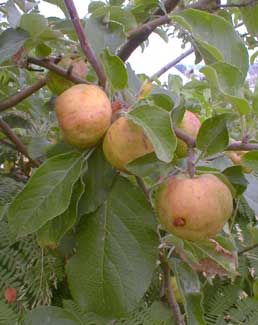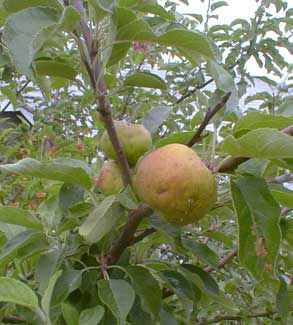
'Stayman Winesap' Apple
"Have you been at Carrick, & saw my true-love there?
And saw you her features, all beautiful, bright, and fair?
Saw you the most fragrant, flowering, sweet apple-tree?
Oh! saw you my loved one, & pines she in grief like me?"
-Edward Walsh
(1805-1850)
(1805-1850)
This dwarf apple tree is growing in the alley across the street. It's been neglected for years, yet it has never gotten large. It's not more than fifteen feet tall despite that no one has been pruning it. It's a bit wider than it is tall & twisted & really very pretty in a maximumly rustic sort of way. It grows halfway down a hill, so that its apples can be picked at eye-level or below from the high alley, although no one bothers & racoons get most of them.
These apples are medium sized, hard & tart but not too tart to be good eating. I was told I could harvest the tree if I want, but I've not had time to do anything with them so only grab one a time when walking about the neighborhood. They're so scruffy they'd be best used for cider or mixed with tart wild berries for something like apple-hawthorn jelly or apple-rowan butter, or for apple cider.
 I believe this is a Stayman Winesap apple tree with the fruits a bit less than ideal because no one waters or fertilizes or prunes the tree. But naming the variety is a hard call. The leaves on this particular tree are larger than average for Staymen Winesaps so I could certainly be guessing wrong as to its identity, but they taste to me like Stayman Winesap (neither too tart nor too sweet in October). In color they are greenish yellow to apricot with rosy streaks in August with more red blush by September's end but never turning into a really red apple. The flesh itself is cream-colored or greenish white.
I believe this is a Stayman Winesap apple tree with the fruits a bit less than ideal because no one waters or fertilizes or prunes the tree. But naming the variety is a hard call. The leaves on this particular tree are larger than average for Staymen Winesaps so I could certainly be guessing wrong as to its identity, but they taste to me like Stayman Winesap (neither too tart nor too sweet in October). In color they are greenish yellow to apricot with rosy streaks in August with more red blush by September's end but never turning into a really red apple. The flesh itself is cream-colored or greenish white. The first Stayman Winesap was seed-grown in 1866 from a Winesap belonging to Dr. J. Stayman of Leavenworth, Kansas. It was introduced in 1895 by Stark Bros. If this old tree is indeed a Stayman Winesap, that'd mean it is a triploid apple unable to pollinate other apples because its pollen is sterile.
Winesaps & Stanley Winesaps are typically planted near a Lodi or a Delicious or Yellow Delicious which will pollinate Winesap even though it will not return the favor. This old tree's partner (for surely it once had one) has long vanished, & it does not fruit well every year, In 2004 it had only a handful of apples, but in 2005 it had excellent production. There are four other apples on the block, none really close enough to pollinate this tree reliably, but one of the oldest apples on the block is enormous (thirty feet high & wide!) & flowers beautifully even though it's long beyond its fruiting prime, & I imagine its pollen covers more than the whole block all by itself.
These apples have reached their full size & are already prettily colored by August but they are by no means ripe. Their flesh is still not fully ripe at September's end, though the skins are no longer changing color. They are as sweet as they'll ever get in October. They remain very firm (so store or cook well) & stay tough to bite into raw, but the flavor is pretty darned good.
Stanley Winesap is not as tart as 'Granny Smith' but not very sweet either, so it rests on the fence between the traits of the best eating apples & best cooking apples. Folks who live further south than apples grow might never encounter this apple because Stayman Winesap is not often grown in commercial orchards; the fruit is prone to cracking, so not ideal for presentation in grocery store produce aisles, & not readily found in the produce distribution system. Yet it is regarded as one of the very best apples for winter pies if you can get it. For reasons of flavor & the tree's small size, it it has never fallen from popularity as a garden apple, & remains one of the more available antique varieties available to gardeners during the bareroot season.